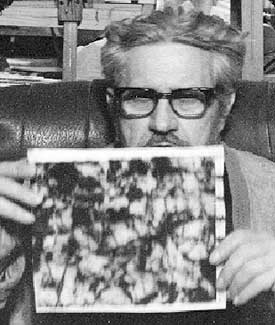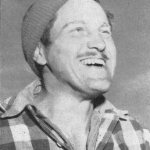 Supernormal revelations arrive in many forms: dreams, voices in the head, fevered visions, the lyrics of a Beatles song, a flash of light on the road to Damascus. But one of the strangest-ever vectors of epiphany has to be the one that kept Richard Shaver busy for the latter years of his life: a bunch of rocks.
Supernormal revelations arrive in many forms: dreams, voices in the head, fevered visions, the lyrics of a Beatles song, a flash of light on the road to Damascus. But one of the strangest-ever vectors of epiphany has to be the one that kept Richard Shaver busy for the latter years of his life: a bunch of rocks.
Richard Shaver (1907-1975) was one of the two men at the centre of the infamous “Shaver Mystery” that enthralled SF readers in the 1940s and 1950s. In his pre-Mystery existence, by his own account, he was a trained artist who took a job on a factory floor in Detroit to support his wife and child—but his life went off the rails on the day his welding torch began picking up mysterious voices that told him terrible things. At that point, the narrative splits into two rather different versions. In the boring version, he went nuts after his brother died, lost his job and family, and ended up spending eight years or so in a mental institution, until his parents sprang him in 1943 and took him to live at home.
The other version was much more exciting. The voices in his welding torch came from sinister beings called Deros, who lived in vast, ancient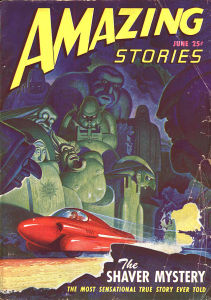 warrens of caves and tunnels deep in the Earth, and delighted in torture, sadistic perversion, and the taste of human flesh. They were ugly, too, with noses like the trunks of mutant elephants. Both telepathically and with advanced technology inherited from the vanished Elder Race, the Deros harassed, implanted dire suggestions into, worked malicious mischief against, and generally made life miserable for the poor sods who lived upstairs (the human race). It was, indeed, a Dero named Max who had killed Shaver’s brother, and was now on the trail of Shaver himself. In fear, Shaver quit his job, took to the road as a hobo, and ran afoul of the law—but while he was in jail, he was spirited away by a lady Tero, one of the good denizens of the underplanet, to spend eight years below ground observing the Deros and having adventures that would certainly make some amazing stories.
warrens of caves and tunnels deep in the Earth, and delighted in torture, sadistic perversion, and the taste of human flesh. They were ugly, too, with noses like the trunks of mutant elephants. Both telepathically and with advanced technology inherited from the vanished Elder Race, the Deros harassed, implanted dire suggestions into, worked malicious mischief against, and generally made life miserable for the poor sods who lived upstairs (the human race). It was, indeed, a Dero named Max who had killed Shaver’s brother, and was now on the trail of Shaver himself. In fear, Shaver quit his job, took to the road as a hobo, and ran afoul of the law—but while he was in jail, he was spirited away by a lady Tero, one of the good denizens of the underplanet, to spend eight years below ground observing the Deros and having adventures that would certainly make some amazing stories.
So he duly wrote them down, and in 1943 contacted the editor of Amazing Stories, a low-grade pulp SF mag. The editor was Ray Palmer, who had a nose for anything that might improve his magazine’s circulation, and thus a thirty-year partnership (or folie à deux, depending on whom you ask) was born. Palmer bought everything Shaver could give him, edited it extensively, and published it as nonfiction. The back-story involved a long-vanished supercivilization of whom the Deros (DEtrimental RObots) were the degenerate troglodyte descendants, rather like Morlocks of HG Wells; and like the Morlocks, they had inherited all sorts of fabulous high tech, which they put to the devilish uses mentioned above. We surface-dwellers could not only be tormented at a distance by the Deros’ mind-control rays, but also kidnapped for use as slaves, sex toys, or—like the Eloi—for meat. (Shaver also claimed, though, that the Deros often climbed up into human cities to buy groceries.) Overall, the Dero mythos comes across like theosophy rewritten as soft porn, with dollops of hard SF, the Fortean Society, and Abraham Merritt, a writer from the 1920s who also influenced Lovecraft.
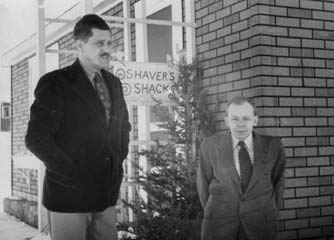
At any rate, it all struck a resounding chord in the burgeoning SF scene of the mid-1940s. Readers wrote in with their own experiences of Dero torment, blaming the underworld demons for their misfortunes in much the same way as people once blamed witches. Clubs were formed and new magazines were spawned, all centred around what became known as the “Shaver Mystery”—until two things happened, towards the end of the 1940s. First, the saner side of fandom rebelled against what they recognized as credulous bilge from a certifiable nutcase; second, the Shaver Mystery was gradually overtaken and pushed aside by an even more intriguing pop culture phenomenon, also at least partly midwifed by Ray Palmer: the advent of the UFO craze. The Fortean writer Bruce Lanier Wright puts it neatly:
Despite its obscurity, the Shaver Mystery still resonates for some of us. A few optimists even believe it gave birth to the entire post-1947 flying saucer phenomenon, although I prefer to think of it as a failed twin, like one of those unsuspected, calcified fetuses that turn up from time to time.
By the mid-1950s, the Shaver Mystery was pretty much sidelined, except for a shrinking core of true believers, which naturally included Richard Shaver. Although Palmer and Shaver remained friends and occasional collaborators, Palmer phased out publishing Shaver’s stories, and the writer faded from view. He did not, however, give up on the Deros. Living on a small farm in Wisconsin, and hideously hampered by the sort of Dero interference that the rest of us would call headaches, he continued to write and publish his own material in ‘zine form. And he received a major revelation when his wife brought him a bunch of agate pebbles, and said it kinda looked like they contained pictures.
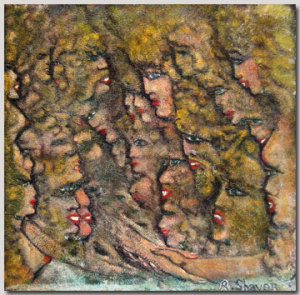 It was then that Shaver had his epiphany. These were no ordinary rocks. They were books, permanent records and artworks left behind by the Elder Race, the nobler ancestors of the Deros; complex multidimensional images had been etched into their very fabric, using the same advanced ray-projection technology that he would need to read them properly. At last, he had physical artifacts of the Elder Race! At last, if he could only read the stones properly, he could learn so much more about the deep history of Earth and the Deros! Alas, lacking the proper technology, he was forced to accept only a fraction of the information embedded in the stones. He sawed them into sections, used a toy projector to enlarge the patterns, and painstakingly teased out the resulting images, enhancing them with paints, dyes, soap flakes, and other media. Eventually, discouraged by the reactions of skeptics, he simply photographed and annotated the images with the amazing revelations they contained.
It was then that Shaver had his epiphany. These were no ordinary rocks. They were books, permanent records and artworks left behind by the Elder Race, the nobler ancestors of the Deros; complex multidimensional images had been etched into their very fabric, using the same advanced ray-projection technology that he would need to read them properly. At last, he had physical artifacts of the Elder Race! At last, if he could only read the stones properly, he could learn so much more about the deep history of Earth and the Deros! Alas, lacking the proper technology, he was forced to accept only a fraction of the information embedded in the stones. He sawed them into sections, used a toy projector to enlarge the patterns, and painstakingly teased out the resulting images, enhancing them with paints, dyes, soap flakes, and other media. Eventually, discouraged by the reactions of skeptics, he simply photographed and annotated the images with the amazing revelations they contained.
Can you spell pareidolia?
The images were astonishing. Shaver’s interpretations were even more so. The images opened up to him a whole world of different elder races:
the half-man-half-woman Amazons, each born with one luscious breast; the Giants, who left Lovecraftian Cyclopean ruins behind them when they vanished; the mer-people, graceful and benign, who inhabited the sea; the forest races, with their long, fluffy tails, the ancestors of the Yetis. Shaver saw a lot of faces in the rocks, but the faces were also letters if you looked at them funny, spelling out texts in the bizarre alphabet he called Mantong. The annotations on one of his rock photos give a flavour of his method (ellipses in the original):
With ordinary 20/20 vision, the above [photo] can seem only confusing. But if you add some thought, some experience with
similar arrangements and if you squint at it until you see only the pattern and not the detail… ..or put a low-powered lens in front of one eye to throw one eye slightly out of focus and cause a stereo type vision… you see an odd sort of man in the center with a pointed beard… and a great many squiggles which seem to have an arrangement… a meaningful and intentional arrangement.
If you know that they used faces much as we do letters and symbols… and the slight difference in profile or hair-do was to them the same difference as adding a bottom bar to an F to make an E. (That is, one profile looks like another unless you know that to them, a sneer on one is the same as a squiggle on a C makes a G.)
However, there is a great deal more to three-dimensional picture-writing than that. Certain angles of light turn all the faces into letters, and a cross-sectioning by the saw doesn’t help this complex arrangement to be more understandable by bisecting the whole thing.
And on another photo:
You do have to learn them [the images], like learning a foreign language. They have a left and right profile in every face, and a
top and bottom profile in every face… every hand gesture has its mirroring four-way fantastic reflection. This is what makes this art 4-way art, any side is the top, and every personality has four sides, four appearances. This means that they either MADE it that way, or they used an unscrambling 4-way mirror in the projection process.
Shaver was an honest man, a true believer, and clearly mentally ill, and he certainly did not get rich off the Dero mythos. Just before his death in 1975, he and his old collaborator Ray Palmer published a compendium of images and writings entitled The Secret World, but only Palmer’s name appears on the cover. It seemed 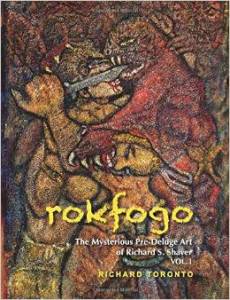 that Shaver was doomed to be forgotten. The kicker is, the paintings he created out of his delusions are now recognized as surrealist outsider art, and have been both exhibited and republished in art-book format. Some of them are stunning. Hollow Earth theorists have adopted him, and the Deros still have true believers; meantime, Shaver’s excellent biographer, Richard Toronto, has revived Shaver’s own ‘zine, Shavertron, and published facsimiles of the originals.
that Shaver was doomed to be forgotten. The kicker is, the paintings he created out of his delusions are now recognized as surrealist outsider art, and have been both exhibited and republished in art-book format. Some of them are stunning. Hollow Earth theorists have adopted him, and the Deros still have true believers; meantime, Shaver’s excellent biographer, Richard Toronto, has revived Shaver’s own ‘zine, Shavertron, and published facsimiles of the originals.
The Shaver Mystery and the Rock Books are bizarre footnotes to SF’s formative years, but they are interesting for far more than that. As an example of pareidolia, the Rock Books are peerless. As for the Shaver Mystery, to quote Bruce Lanier Wright again, “it marks a rare intersection between the worlds of science fiction fandom and paranormal kookery, two subcultures that share many curious links, as little as either side might wish to acknowledge them.”

